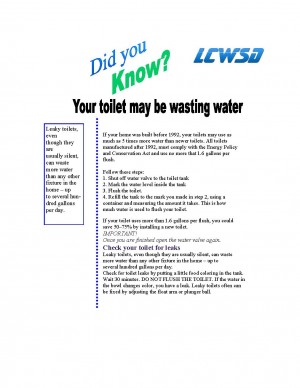The Complete Meter Test
Below are instructions on how to check your meter to find out how much water is being used due to a leak. Knowing the volume of loss will help your leak specialist to understand the potential size of the leak. Also, after a leak detection repair is completed, check the meter again to make sure all the leaks have been repaired.
- This test should be conducted for a 30 minute period, during which time no water is being used on the property.
- Find your water meter, which is usually located in front of the house in a covered box near the street.
- Write down the numbers indicated on the meter at the start of this test.
- Return to check the meter reading after 30 minutes have passed.
- If the numbers have not changed, you do not have a leak in your pressurized water system.
- If the numbers have changed, continue with the following steps.
- Shut off the valves under all toilets in the house, and repeat steps 1-4.
- If the numbers have not changed, you may have a running toilet that should be serviced.
Leak Facts
- A 1/8 inch hole in a metal pipe, at 40 psi, leaks 2,500 gallons of water in 24 hours.
- A leak the size of a pinhead can waste 360,000 gallons per year, enough to fill 12,000 bathtubs to the overflow mark.
- A leaking toilet can use 90,000 gallons of water in 30 days.
- A dripping faucet/hose bib can lose up to 180 gallons a month or 2,160 gallons per year.
- Approximately 1 in every 20 pools has a leak.
- Approximately 1 in every 318 homes or buildings has a leak.
- One trip through a car wash uses 150 gallons of drinking water.
- Collecting water for gardening from the faucet while waiting for hot water saves about 250 gallons of water a month.
- Using a broom to clean the sidewalk instead of a hose saves 150 gallons of water.
Toilet Leak Test
Use food coloring or powder drink mix (Kool Aid) to Check for Toilet Tank Leaks. Do you hear water running inside your toilet tank in between flushes? There's probably a leak in there that needs to be repaired. An easy way to detect a leak is to use food coloring to soft drink powder works the best because you can see it better.
To make it easier for you to detect possible toilet leaks we now have tablets specifically designed for this test. The instructions are printed on the small packet and they are the same as if you were using powdered drink mix(Kool Aid). Just drop by our office and request these tablets and you can receive them free of charge. It’s just one way that we want to help customers determine if they have a toilet leak to help you save money and water as well.
- Carefully lift the lid off the toilet tank and set it aside.
- Pour a small amount of food coloring or soft drink powder mix into the tank. The test can take as little as ten minutes or as long as thirty minutes, depending on the size of the leak.
- Don’t flush the toilet! Just watch the toilet bowl. If you see the colored water in the bowl of the toilet from the tank, then there’s a leak present. It’s quite possibly the flapper piece. But, you’ll have to investigate further to determine the exact cause.
You may have a plumbing leak if...
- You can hear the continuous sound of water (like a toilet running) when nothing is turned on.
- Your water meter reading changes when you aren’t using any water. (Mark the indicator on your meter; don’t use any water for an hour; then check the meter. If the indicator moved, you may have a leak.)
- Your water bill escalates over a period of weeks or months (compare your bills month to month).
- Your walls or floors have wet, spongy, moist or discolored areas when nothing has been spilled.
- You can smell foul odors coming from floors or walls near drains or sewers.
- Your building foundation cracks, vegetation grows unevenly, or earth shifts for no apparent reason.
- You find warm spots on your floor, particularly on concrete slab floors.


